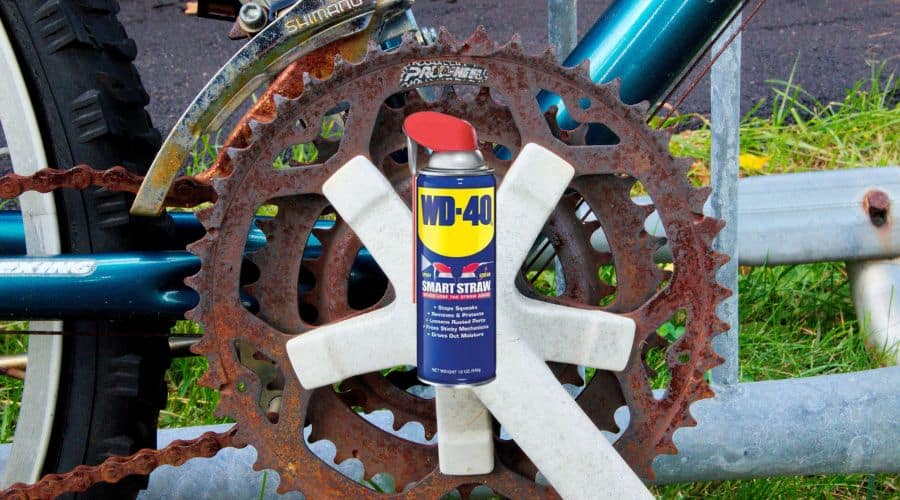Your bike spends a lot of time outdoors, which means it is surrounded by moisture and pollution that can contribute to rust. Besides making your bicycle ugly, rust also interferes with its performance, and if left unattended, it can completely ruin the bike’s structural integrity.
Thankfully, several things can help you remove rust from your bicycle, including WD-40, an effective rust remover.
To remove rust from a bike, spray WD-40 on your handlebars, spokes and chain and leave it for 10 minutes to penetrate and dissolve the rust layers. Use a wire brush to scrub the grime and work the WD-40 into the bike chain. Use a cloth to wipe the WD-40 off from your bike parts to reveal rust-free surfaces.
Recommended Gear
To see all of my up-to-date recommendations for bikes and cycling gear, check out this resource that I made for you!
Table of Contents
How To Remove Rust From Bike Handlebars With WD-4O
Many people prefer natural remedies like baking soda and vinegar when it comes to rust removal.
However, if the stains are stubborn, you need stronger solutions to get rid of them. WD-40 is a rust removal chemical that can be used on metal surfaces.
It is made up of potent ingredients combined to get rid of rust. The spray penetrates and dissolves the rust leaving your metal surface clean and shiny.
Here is how to use WD-40 to remove rust from your bicycle handlebars.
Step 1: Assemble The WD-40
Many of us have WD-40 in our houses. But if you don’t have it, the first step would be to get the spray.
This product comes in a blue bottle with a red lid. To use it, fix the long connecting hole’s spray part on the lid.
Therefore, you shouldn’t have problems using this spray once these parts are attached. The spray has a smart chain that lets you work on difficult-to-access areas.
Step 2: Spray WD-40 On The Handlebars
One of the best things about using WD40 is that it is straightforward. You only need to spray it on rusted areas and leave it for 10 minutes.
If you are cleaning your handlebars, spray the product and give it time to penetrate.
Once WD-40 soaks onto your handlebars, removing rust will be much easier and quicker. However, I should mention that this product only offers temporary protection against rust.
So, please do not use it as a permanent solution as it won’t work.
Step 3: Wipe WD-40 Off To Remove Rust
Since the rust particles have been dissolved, all you need to do is wipe down the disintegrated rust. You can use an old towel or a cloth for that.
If you still have rust on your handlebars after wiping, think of repeating the above steps.
Repeat as many times as needed for all the rust to come out. But, most people don’t need to soak more than twice since this chemical cleaner is very effective.
How To Remove Rust From Bike Chain With WD-40
Rust on your bike chains reduces your performance and creates unsafe conditions for riding.
For this reason, all riders need to know the basics of bike lubrication and maintenance to ensure a smooth and safe ride.
WD40 offers various lubrication designed for regular bike maintenance. So you can buy one suitable for your environment.
But, let’s face it. Even with utmost care and maintenance, rust can still occur. So, if you have spotted rust on your bike chains, don’t worry, as this is completely normal.
Thankfully, various cleaning agents can help remove it. Generally, there are two ways of removing rust from bike chains; using lubricants (WD-40) and waxes.
Let’s look at the steps to follow to remove rust on the bike chains with WD-40.
Step 1: Gather The Needed Equipment
You will need a degreaser, a cleaning brush, soapy water, WD-40 lubricant and an old rag.
Please bear in mind that WD-40 is more of a cleaner than a lubricant, meaning you will still have to lubricate your bike chains.
Step 2: Inspect Your Bike Chain
You can’t start cleaning rust off if you don’t know where it is. Therefore, the first step is to inspect your bike and find where the rust built is.
Remember that rust doesn’t affect the whole bike chain but only portions, which is why this step is crucial.
To see your bike chain clearly, I recommend turning it upside down or placing it on a bike rack or stand.
If you don’t have a bike stand, you can hang it onto a wall. When inspecting it, it is crucial to ensure that the bicycle is leaning on a stable, sturdy surface.
Once you’ve hung it, check it for any rust and dirt occurrence. Please do a thorough inspection to examine parts that need to be cleaned and rust brushing.
When doing this, check the overall condition of the chain. Sometimes, the rust may be too much to be removed. In that case, replacing it will be better.
Check for chain color inconsistencies, imperfections, warping, etc.
Step 3: Detach The Chain From The Bike
You will need to remove the chain from your bicycle to clean it properly. Start by locating the master link, then move it gently from the bike.
It shouldn’t be hard to identify the master link as it is different from the other chains. Once you spot it and disconnect it from the rest of the chain, remove the entire chain.
Please ensure that the chain is entirely detached from the bike. This will show you properly where the rust is.
Step 4: Clean The Rust Surface
Wiggle the chain to remove dirt and other material buildups. Then wipe it with a piece of cloth.
Next, remove another rust layer using a degreaser and a scouring pad. Dampen the scouring pad/clean rag with your degreaser and wipe the chain using some force.
You should see stubborn rust that wasn’t removed by wiggling fall off. Remember that while you should apply pressure when cleaning, you don’t need to overdo it.
Step 5: Soak Your Bike Chain In Grime And Degreaser
Even after scrubbing, you will still notice rust on the chain. To remove this, soak the chain with a degreaser and heavy grime for about 20 minutes, then rinse in hot water to clean off the degreaser and broken rust particles.
When soaking, think of wiggling the chain to remove unnecessary particles. Please ensure you wear protective gloves during this step.
Step 6: Use WD-40 To Remove Stubborn Stains
Rust might persist even after doing the above process. And in most cases, it does persist. Thankfully, here is where WD-40 comes in.
Spray your chain using this product. Please aim directly at the rusted parts when spraying. Then, allow it to sit for some minutes before wiping it out.
If there is still rust, repeat the process until it comes out.
Step 7: Lubricate And Put Back The Chain
Once rust is removed, use the right lubricant to lubricate the chain, then after, attach it back.
To do that, identify the chain’s end, slide its master link and join it again. When you hear a click sound, you are sure that the ends are joined together.
How To Remove Rust From Bicycle Spokes With WD-40
Removing rust from bike spokes is a bit challenging. But it isn’t impossible, and they will look great once done. Here are the steps to follow:
Step 1: Collect The Needed Equipment
To remove rust on bike spokes, you will need an anti-rust spray (WD-40), soapy water, a sponge, steel wool and a dry cloth.
Step 2: Rub The Spokes Using The Steel Wool
You will need to rub each spoke individually to get rid of rust. Make sure you pinch the wool around them and move it along the spokes from top to bottom.
Please pay more attention to areas where there is excessive rust.
It is recommended to have about three steel wool pads so that you can change them once the one you’re using starts falling apart.
It will take some hard work, but you will notice the rust breaking off the spokes.
Step 3: Wipe Down And Clean Using Warm Soapy Water
Use a dry cloth to wipe down the broken rust particles. Then, mix dish soap with warm water.
Please ensure the water is warm or even hot to loosen rust from the surface. Cold water won’t be that effective in treating rust.
You can also think of adding several drops of lemon oil to the solution if you have it.
Then use the mixture to scrub your spokes. Be gentle when starting, then gradually increase the pressure on stubborn areas.
Once you are done, rinse your spokes, preferably using a garden hose. Then, use a dry cloth to wipe the remaining moisture.
Step 4: Spray WD-40
Now that your spokes are clean and the stubborn dirt has loosened up, it’s time to spray your anti-rust spray.
Please note that you can skip the above steps and directly spray your spokes. But that won’t be as effective.
These processes are crucial to ensure that rust comes completely off your bike spokes.
Once you spray your spokes, leave WD-40 to stay for some minutes, about 10-20. Then, wipe the spokes using a microfiber cloth and store your bike.
Helpful Tips To Know About How To Remove Rust From Bike With WD-40
WD-40 is an effective anti-rust spray to be used on metal surfaces. It can help remove rusted parts on your bike.
However, you need to keep several things in mind for the WD-40 to be effective:
- Cover all rust with this chemical- spraying WD-40 partially won’t help remove rust. You need to be generous and ensure you spray on all rusted parts. This is why taking the bike chain off is crucial to allow you to access all parts.
- Leave it for some minutes- WD-40 needs time to penetrate and break down rust particles. So, don’t spray and wipe it off immediately. Allow 10-20 minutes or even more for the solution to work.
- Lubricate your bicycle- as I said earlier, this spray is a cleaning agent, not a lubricant. To prevent rusting and keep your bike in good shape, make sure you lubricate with a lubricant of your choice after removing rust.
Final Thoughts
Proper care and maintenance are crucial in extending the lifespan of your bicycle. While removing rust can be challenging, a chemical product like WD-40 can help.
I hope this guide helped you learn how to use this product to remove rust off your bike.



